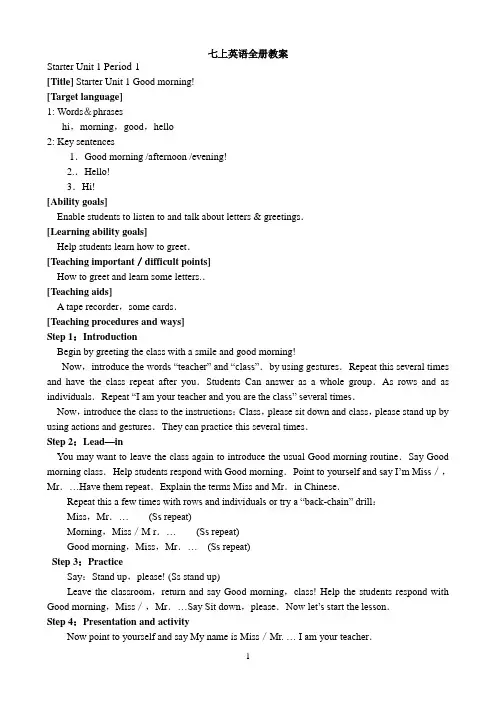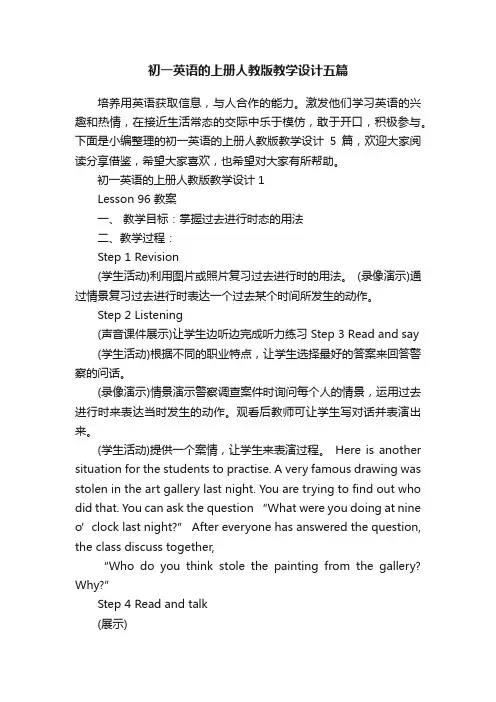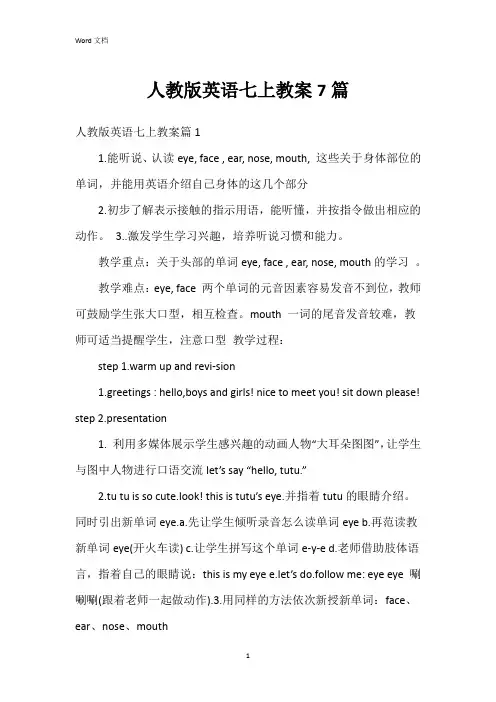七年级上册英语教案全套
人教版初一英语上册教案15篇

人教版初一英语上册教案15篇人教版初一英语上册教案【篇1】教学年级:七年级课程名称:Unit 3 Why do you like koalas?教材版本:人民教育出版社授课时间:40分钟(一)学生分析:1.本班学生对学习英语较感兴趣,能积极参加各种调查、采访、表演等实践活动。
2.学生学习动机明确,学习态度积极主动,能主动与他人合作,相互帮助,共同完成学习任务,遇到问题敢于主动向老师和同学请教,能大胆用英语交流。
(二)教材分析:本课时的内容是义务教育课程标准实验教科书英语新目标“Go for it!”七年级的《Unit 3 Why do you like koalas?》第一课时,主要话题是学习动物名称,并讨论喜好某种动物的原因。
通过话题的讨论喜欢动物的原因,增强了动物名称的词汇量,还增强课堂学习趣味性。
(三)教学目标语言知识目标1.学习有关动物的名词:tiger elephant koala dolphin panda lion penguin giraffe2.学习并运用品质的.形容词:cute smart shy ugly clever beautiful friendly quiet lazy来描述动物.3.掌握下列句型Why do you like…?. Because they’re….使学生熟练表达喜好并陈述原因。
语言能力目标1.学生能熟练谈论自己喜爱的动物并给出理由。
2.学生的口语和书面表达能力得到提高。
3.培养学生主动参与语言实践活动的能力,在游戏和小组竞赛中培养学生乐于表达、勇于展示自我的能力,从而树立学习英语的信心,获取成功的喜悦。
情感目标1.通过学习要培养学生自觉保护动物的意识。
2.培养学生积极参与,发扬团队合作的精神和竞争意识。
(四)教学策略1、教学方法Task-based, Language Teaching,途径:Guesing game, group work, pair work, survey, Internet teaching.2、教学辅助手段采用多媒体电脑投影图片,充分利用网络教材资源,扩大学生的知识面,激发学生的兴趣和求知欲。
人教版七年级英语上册教案全套

S: Good morning, I’m Jacky Cheng.
T: Nice to meet you, Jacky.
S: Nice to meet you, too. Bill.
Encourage the students to care what kind of English they can find in the street or in the other ways. Show the students some CDs and ask them if they know what it is. Repeat with the other things. And add some more things such as DVD and KFC. Train the students to care the things happening around them, such as: ID means identification card. OK means all right. Then get them to finish the exercise on the screen. Go on doing the above step to ask them to list more about the abbreviation. (See the powerpoint)
S2:Nice to meet you.too.
Call out several pairs of students to give their performance.Praise their efforts as much as possible.Help the slower students with patience.
译林版七年级上册英语全册教案5篇

译林版七年级上册英语全册教案5篇译林版七年级上册英语全册教案1一、教学设计思路用真实衣物做道具模拟情境,帮助学生练习谈论物品的颜色和价格;配以图片、视频歌曲等多媒体手段,加深学生印象。
二、教学目标(一)知识1.掌握如何谈论物品的颜色和价格:Howmuchis/are…?Its/Theyre…dollars.black,white,red,green,blue,yellow2.掌握衣物的名称:socks,T-shirts,pants,shorts,sweater,hat3.掌握数字10-314.掌握购物礼貌用语:CanIhelpyou?Illtake…Thankyou.Yourewelcome.(二)能力能够在生活中买必要的东西。
(三)情感在生活中要应用礼貌用语。
三、教学重点谈论价钱四、教学难点结合物品的颜色、数量等询问和回答价钱。
五、教学媒体常见衣物;电脑;投影仪六、教学过程(一)巧妙导入方法1:通过询问学生衣服的颜色复习颜色词汇,进而引出衣物的话题。
方法2:拿出不同种类的衣物引起学生注意,进入话题译林版七年级上册英语全册教案2学习目标:1.掌握本节课的13个单词.2.初步介绍一下复数的概念.3.学会运用介绍人的句型:This/thatis...以及these/thoseare和询问人的句型Isthis/that...学习重难点:掌握指示代词this/these,that/those的用法学习过程:一、自主学习学习任务一:熟练掌握本节课的词汇.1.个人试读,组内相互纠正发音.2.老师领读,学生自己纠正自己的发音.3.自己读并记住汉语意思,组内检查.4.小组竞赛,看谁记的多而快.5.认真观察1a的图片,将单词与图中的人物搭配,小组讨论并核对答案.6.听录音,完成1b,小组核对答案.学习任务二:1.听录音,完成2a.2b,小组核对答案.2.介绍家人,引入复数的概念.Thisismyf________,andthisismym________.Theyaremyp_________.把下列单词变为复数形式.mother—__________father—_________brother—_________sister—________friend—___________grandfather—____________grandmother—____________总结名词变复数的规则:______________________________________不规则变化this—__________that—_________is—__________学习任务三:熟练运用介绍人的句型:This/thatis以及These/thoseare和询问人的句型Isthis/that┅1、看图片1a,引入:ThisisDave.Thisishissister.2、用Thisis┅Theseare┅句型依次介绍Dave的其他家人。
初一英语的上册人教版教学设计五篇

初一英语的上册人教版教学设计五篇培养用英语获取信息,与人合作的能力。
激发他们学习英语的兴趣和热情,在接近生活常态的交际中乐于模仿,敢于开口,积极参与。
下面是小编整理的初一英语的上册人教版教学设计5篇,欢迎大家阅读分享借鉴,希望大家喜欢,也希望对大家有所帮助。
初一英语的上册人教版教学设计1Lesson 96 教案一、教学目标:掌握过去进行时态的用法二、教学过程:Step 1 Revision(学生活动)利用图片或照片复习过去进行时的用法。
(录像演示)通过情景复习过去进行时表达一个过去某个时间所发生的动作。
Step 2 Listening(声音课件展示)让学生边听边完成听力练习 Step 3 Read and say (学生活动)根据不同的职业特点,让学生选择最好的答案来回答警察的问话。
(录像演示)情景演示警察调查案件时询问每个人的情景,运用过去进行时来表达当时发生的动作。
观看后教师可让学生写对话并表演出来。
(学生活动)提供一个案情,让学生来表演过程。
Here is another situation for the students to practise. A very famous drawing was stolen in the art gallery last night. You are trying to find out who did that. You can ask the question “What were you doing at nine o’clock last night?” After everyo ne has answered the question, the class discuss together,“Who do you think stole the painting from the gallery? Why?”Step 4 Read and talk(展示)Read the table about what David was doing at different times yesterday, then ask and answer in pairs.(录像演示)情景演示询问过去某个时间点正在进行的动作,看后让学生进行模仿练习。
人教版英语七上教案7篇

人教版英语七上教案7篇人教版英语七上教案篇11.能听说、认读eye, face , ear, nose, mouth, 这些关于身体部位的单词,并能用英语介绍自己身体的这几个部分2.初步了解表示接触的指示用语,能听懂,并按指令做出相应的动作。
3..激发学生学习兴趣,培养听说习惯和能力。
教学重点:关于头部的单词eye, face , ear, nose, mouth的学习。
教学难点:eye, face 两个单词的元音因素容易发音不到位,教师可鼓励学生张大口型,相互检查。
mouth 一词的尾音发音较难,教师可适当提醒学生,注意口型教学过程:step 1.warm up and revi-sion1.greetings : hello,boys and girls! nice to meet you! sit down please! step2.presentation1. 利用多媒体展示学生感兴趣的动画人物“大耳朵图图”,让学生与图中人物进行口语交流let’s say “hello, tutu.”2.tu tu is so cute.look! this is tutu’s eye.并指着tutu的眼睛介绍。
同时引出新单词eye.a.先让学生倾听录音怎么读单词eye b.再范读教新单词eye(开火车读) c.让学生拼写这个单词e-y-e d.老师借助肢体语言,指着自己的眼睛说:this is my eye e.let’s do.follow me: eye eye 唰唰唰(跟着老师一起做动作).3.用同样的方法依次新授新单词:face、ear、nose、mouth4.powerpoint制作:打开幻灯片后每点击一身体部位就会出现相应的单词。
(注mouth一词的尾音发音较难,适当提醒学生,注意口型。
)5.认读face、ear、eye、nose、mouth的单词卡片和图片。
step3:practice1.let’s do: eye eye 唰唰唰ear ear 呼呼呼nose nose 闻闻闻mouth mouth 巴巴巴face face 拍拍拍2.i say you do.(老师说,学生快速做相应的动作,然后找一位学生出来做出动作。
初一上册英语教案

初一上册英语教案(经典版)编制人:__________________审核人:__________________审批人:__________________编制单位:__________________编制时间:____年____月____日序言下载提示:该文档是本店铺精心编制而成的,希望大家下载后,能够帮助大家解决实际问题。
文档下载后可定制修改,请根据实际需要进行调整和使用,谢谢!并且,本店铺为大家提供各种类型的经典范文,如工作总结、工作计划、演讲致辞、规章制度、合同协议、条据文书、励志名言、好词好句、教学资料、其他范文等等,想了解不同范文格式和写法,敬请关注!Download tips: This document is carefully compiled by this editor. I hope that after you download it, it can help you solve practical problems. The document can be customized and modified after downloading, please adjust and use it according to actual needs, thank you!Moreover, our store provides various types of classic sample essays, such as work summaries, work plans, speeches, rules and regulations, contract agreements, policy documents, inspirational quotes, good words and sentences, teaching materials, other sample essays, and more. If you want to learn about different sample formats and writing methods, please stay tuned!初一上册英语教案初一上册英语教案【5篇】教案为教师提供了指导和支持,明确了教学的目标和方法。
2024-2024年学年秋季学期人教版pep初中七年级英语上册教案全册
2024-2024年学年秋季学期人教版pep初中七年级英语上册教案全册一、教学目标1.让学生掌握基本的英语语音、词汇和语法知识。
2.培养学生的英语听说读写能力。
3.激发学生对英语学习的兴趣,提高学生的综合素质。
二、教学内容1.语音:字母、音标、语音规则2.词汇:基本词汇、常用短语3.语法:一般现在时、一般过去时、一般将来时4.课文:Unit1-Unit85.听力:与课文相关的听力材料6.口语:日常交流、情景对话7.阅读:课文阅读、课外阅读8.写作:句子、段落、小作文三、教学重点与难点1.教学重点:基本语音、词汇、语法知识的掌握听说读写能力的培养课文的熟练阅读和背诵2.教学难点:音标发音的准确性语法规则的灵活运用课外阅读的理解与分析四、教学进度安排1.第一周:Unit11.1Greetingsandintroductions 1.2Numbersandages1.3Colors2.第二周:Unit22.1Schoolsubjects2.2Classroomobjects2.3Dlyroutines3.第三周:Unit33.1Foodanddrink3.2Describingfood3.3Makingrequests4.第四周:Unit44.1Familymembers4.2Describingpeople4.3Talkingaboutfamily5.第五周:Unit55.1Time5.2Daysoftheweek5.3Activities6.第六周:Unit66.1Weather6.2Clothing6.3Describingtheweather7.第七周:Unit77.1Inthelibrary7.2Intheclassroom7.3Inthesupermarket8.第八周:Unit88.1Sports8.2Describingsports8.3Talkingaboutsports五、教学方法1.采用任务型教学法,让学生在实际语境中学习英语。
七上英语教案
七上英语教案教案一:Unit 1: Introduction to English【教学目标】1. 通过比较中英文语言特点,了解英语的基本特点和使用范围;2. 通过学习不同国家的国旗和国家名称,了解不同国家的英文表达方式;3. 学会用英语自我介绍。
【教学重点】1. 英语的基本特点和使用范围;2. 不同国家的国旗和国家名称的英文表达;3. 用英语进行简单的自我介绍。
【教学难点】用英语进行自我介绍。
【教学准备】幻灯片、英语国旗图片、学生姓名卡片、学生个人简介表格等。
【教学过程】Step 1: Lead-in1. Show pictures of different national flags and ask students if they know which countries they represent.2. Teach the English names of these countries and encourage students to repeat after you.3. Ask students if they know any other countries and their English names. Write down the names on the board.Step 2: Introduction to English1. Show a picture of an English book and ask students if they know what language it is.2. Discuss with students the similarities and differences between Chinese and English.3. Write down the key characteristics of English on the board. Step 3: English Self-introduction1. Divide the students into pairs and distribute the student name cards and personal introduction sheets.2. Demonstrate how to introduce oneself in English.3. Have students practice introducing themselves to each other in English.4. Select several students to share their introductions with the whole class.【教学延伸】1. 让学生以小组形式互相交换姓名卡片,并用英语互相介绍。
七年级英语上册人教版全册教案
七年级英语上册人教版全册教案第一章:引言1.1 教学背景1.1.1 分析学生情况:针对七年级学生,英语学习处于基础阶段,需要引导学生逐步适应英语学习。
1.1.2 教材内容:人教版七年级英语上册,以话题为主线,培养学生的基本语言能力。
1.1.3 教学目标:激发学生学习兴趣,建立良好的学习习惯,为后续学习打下基础。
第二章:知识点讲解2.1 语音知识2.1.1 发音规则:介绍长元音、短元音、辅音等发音规则。
2.1.2 语音练习:通过听力练习,让学生辨别单词的正确发音。
2.1.3 语音应用:引导学生运用语音知识正确拼读单词和句子。
2.2 词汇知识2.2.1 单词构成:分析单词的词根、前缀、后缀等构成部分。
2.2.2 词汇练习:通过词汇游戏、练习册等途径,巩固单词记忆。
2.2.3 词汇应用:让学生在实际语境中运用词汇,提高运用能力。
2.3 语法知识2.3.1 基本句型:介绍主谓宾、主谓表等基本句型。
2.3.2 语法规则:讲解时态、语态、比较级、最高级等语法规则。
2.3.3 语法练习:通过填空、改错等形式的练习,巩固语法知识。
第三章:教学内容3.1 课本内容3.1.1 每课主题:根据课本内容,提炼每课的主题。
3.1.2 对话分析:分析对话内容,讲解重点词汇和句型。
3.1.3 课文理解:引导学生理解课文,提高阅读能力。
3.2 拓展内容3.2.1 相关话题:针对课本内容,拓展相关话题。
3.2.2 听力练习:选择合适的听力材料,提高学生听力水平。
3.2.3 口语表达:组织口语交流活动,提高学生口语表达能力。
第四章:教学目标4.1 知识目标4.1.1 掌握基本的语音、词汇和语法知识。
4.1.2 能够听懂、说出一日常用语。
4.1.3 理解课本内容,具备一定的阅读和写作能力。
4.2 能力目标4.2.1 提高学生的听、说、读、写四项基本技能。
4.2.2 培养学生的语言运用能力和团队协作能力。
4.2.3 培养学生的跨文化交际意识。
全新人教版七年级英语上册全英文教案(全册 全英文p)
全新人教版七年级英语上册全英文教案(全册全英文全新人教版七年级英语上册全英文教案(全册全英文共132页)Starter Unit 1Good morning!Period 1 (1a~2e)Teaching important points【教学重点】1.Key words & phrases:good,morning,hi,hello,HB,CD,BBC2.Key sentences:Good morning!Teaching difficult points【教学难点】Grasp the letters Aa-Hh and learn to recognize the English names.Teaching aids【教具】a computer and some cardsTeaching procedures and ways【教学过程及方法】★Step Ⅰ Revision and lead-in复习导入Greet the students and lead in the new lesson.T:Good morning,everyone!My name is…I am your English teacher.You can call me Miss/Ms./Mr. …(Walking to a boy)What's your name?Boy:My name is Li Tao.T:Good morning,Li Tao.Boy:Good morning,Ms./Mr. …(Help the student to respond correctly if necessary.)The teacher writes “Good morning,Li Tao.”on the blackboard.★Step Ⅱ Self-studying and guiding自学指导Self-study guide 1:Self-study the new words and English names:good,morning,hi,hello,Alice,Bob,Cindy,Dale,Eric,Frank,Grace,Helen.Learn to pronounce them according to the phonetic symbols(音标).And you can listen to the tapes to help you pronounce them correctly or ask others for help.Self-study guide 2:Try reading the sentences in 1a and try to tell boys' names from girls' names.Self-study guide 3:Self-study 2c and learn to write the eight letters.Questions for thinking:1.Do you know how to greet people in the morning?2.Do you know how to write the eight letters Aa,Bb,Cc,Dd,Ee,Ff,Gg,Hh?The teacher walks around the classroom to watch and help the students study while the students are self-studying.Time for questions:Discuss the writing of the eight letters.★Step Ⅲ Check up检查核对Check up 1:Words teaching:Ask a few students to read the new words and help them correct the mistakes in pronunciation if necessary.Check up 2:Ask some students to make a conversation with their partner and see if they can respond correctly.And ask students to fill in the blanks:Boys' names:________________________________________________________________________ Girls' names:________________________________________________________________________Check up 3:Write the small letters for these big letters:A____B____C____D____E____F____G____H____★Step Ⅳ Cooperative inquiry合作探究1.Listening (1b)Play the recording of 1a,students listen and repeat.2.Pair workPractice the conversations in the picture and then greet your partner.(1c)Sample:A:Good morning,Zhang Wen!/Hello,Zhang Wen!B:Good morning,Li Yan!/Hello,Li Yan!3.Act outAsk some pairs of students to act out their dialogs in front of the class.4.Finish 2a and 2b.5.Discussion (2e)Talk about what these letters HB,CD,BBC mean.★Step Ⅴ Practice练习Write the missing big letter or small letter for each pair.(2d)★Step Ⅵ Test测试Choose the best answer.()1.书写英文字母时,占三格的是________。
- 1、下载文档前请自行甄别文档内容的完整性,平台不提供额外的编辑、内容补充、找答案等附加服务。
- 2、"仅部分预览"的文档,不可在线预览部分如存在完整性等问题,可反馈申请退款(可完整预览的文档不适用该条件!)。
- 3、如文档侵犯您的权益,请联系客服反馈,我们会尽快为您处理(人工客服工作时间:9:00-18:30)。
Starter Unit 1 Good morning!No. 110 Middle School by Cao Yi课程目标一、知识和能力目标本单元要求学生掌握英文字母A—H,能认读其印刷体和手写体字母的大小写等四种形式。
书写(大写和小写,笔顺,笔画)基本合乎要求。
能看,听,说本单元所列的日常交际用语,重点学会打招呼,并做到语音语调正确。
注意一些字母及日常交际用语的发音,提醒学生不要将C/si:/发成/sei:/; H /e✋ʧ/发成/eʧ/,也不要将Good morning/♈◆♎'❍⏹✋☠说成/♈◆♎♏'❍⏹✋☠/等。
二、过程和方法目标教师要尽量用英语组织教学。
充分利用课堂的40分钟,不讲或少讲汉语,尽量给学生创造英语情景。
教师可以用手势,表情,动作等示意,帮助学生听懂课堂用语和日常交际用语,第一次介绍某个用语时,说英语,加译文及手势,以后可酌情省去译文,最后只说英语,逐步让学生听懂。
三、情感态度和价值观目标万事开头难,首先利用这个单元培养学生们对英语的兴趣,因为兴趣是最好的老师。
学情分析体会打招呼用语的奥妙所在,做到灵活运用。
1.Good morning /afternoon /evening:适用于比较正式客气的场合,双方都应说Good morning /afternoon /evening!例如:A:Good morning,Miss Zhao.早晨好,赵老师。
B:Good morning,Mr.Wang.早晨好,王校长。
2.Morning:适用于比较熟悉的朋友之间或比较繁忙的情况下。
3.Hello:是最广泛、最简单的打招呼语,显得亲切自然。
例如:A:Hello,Kate.你好,凯特。
B:Hero,Li Lei.你好,李雷。
4.Hi:在现代英语中,Hi比Hello用得更多,显得更随和。
例如:A:Hi,Han Meimei.你好,韩梅梅。
B:Hi,Lucy.你好,露西。
教学准备tape—recorder,multi—medium.课时参考四课时Period 1Step 1:IntroductionBegin by greeting the class with a smile and good morning!Now,introduce the words “teacher” and “class”.by using gestures.Repeatthis several times and have the class repeat after you.Students Can answer as a whole group.As rows and as individuals.Repeat “I am your teacher and you a re the class” several times.Now,introduce the class to the instructions:Class,please sit down and class,please stand up by using actions and gestures.They can practice this several times.Step 2:Lead—inYou may want t0 leave the class again to introduce the usual Good morning routine.Say Good morning class.Help students respond with Good morning.Point to yourself and say I’m Miss/,Mr.…Have them repeat.Explain the terms Miss and Mr.in Chinese.Repeat this a few times with rows and individuals or try a “back-chain” drill:Miss,Mr.… (Ss repeat)Morning,Miss/M r.… (S s repeat)Good morning,Miss,Mr.… (Ss repeat)Step 3:PracticeSay:Stand up,please! (Ss stand up)Leave the classroom,return and say Good morning,class! Help the students respond with Good morning,Miss/,Mr.…Say Sit down,please.No w let’s sta rt the lesson.Step 4:Presentation and activityNow point to yourself and say My name is Miss/Mr. … I am your teacher.Find a student you know and say your name is…(Beth).Then ask What is your name? Help them respond with My name is… . When the student answers, respond with Hel lo…Nice to meet you! Repeat this activity several times,first with students you know and then with others.Help them to respond with Nice to meet you,too.Explain the Word “too’’ in Chinese.Step 5:PracticeGet the students to practice the f0llowing dialogue in pairs.S1:Good morning.S2:Good morning.I’m (Ben).What’s your name?Sl:My name is (Dale).Nice to meet you!S2:Nice to meet you.too.Call out several pairs of students to give their performance.Praise their efforts as much as possible.Help the slower students with patience.Step 6:PresentationDo activity 1a:Look at the picture.Find the small letters for these big letters.First present letters a-h,and get the students to repeat these letters.Call the students to attention the letter C/si:/not/sei:/.H /e ʧ/ not /eʧ/Step 7:Listening and writingGet the students to listen to the tape and finish the task list on the book.Make sure all the students know what they should do.Have the students watch the teacher writing the letters on the blackboard, then ask them to follow the teacher and write down these letters on their exercise—books.Let the students know thediffences between the big letters and the small letters.Step 8:Games timeLet the students do some letters games to enjoy your lesson,the following is the instruction.抢读字母游戏:教师将全班分成若干小组,然后逐个出示字母卡片,学生们举手抢答。
教师让最先举手的学生读出该字母,读对的给该组记lO分,得分最多的组为优胜组。
Step 9: HomeworkCopy the conversation and letters. (Do entering famous school)Period 2Step 1:Lead—inDo free talk:Greet students and ask them to greet each other. Play a role game. Ask students to collect information about their idols such as Bill Gates, Thomas Edison, Jacky Cheng and so on and write their names down. Get them act as their idols and introduce themselves to their partners. The following is sample:T: Good morning, My name is Bill Gates.S: Good morning, I’m Jacky Cheng.T: Nice to meet you, Jacky.S: Nice to meet you, too. Bill.Encourage the students to care what kind of English they can find in the street or in the other ways. Show the students some CDs and ask them if they know what it is. Repeat with the other things. And add some more things such as DVD and KFC. Train the students to care the things happening around them, such as: ID means identification card. OK means all right. Then get them to finish the exercise on the screen. Go on doing the above step to ask them to list more about the abbreviation. (See the powerpoint)Step 2:PairworkLet students work in pairs to practice the dialogue on 3a.Get them to act it out after practicing. Do 3b.Make sure all the students know the answers correctly. Let the students try their best to remember how to pronounce all the names.Let the students tryStep 3:PracticePlay the tape and ask the students to sing after it in chorus and individual. Give them a chance to perform.Praise their efforts as much as possible.Help the slower students with patience.Step 4:HomeworkCopy the letters and the new words and finish off the workbook. (Do entering famous school)Period 3Step 1: Lead-inBegin the class with singing the song of “Good morning” together. Free talk. Ask : Hi! Good morning, Tom. Or Morning, Dale. etc. Let the students get used to speaking English in class,even after class, Encourage the students to speak English as much as possible.Say out all the letters in English while you are pointing the letters or things in the classroom.Make sure all the students know what you are saying and what it is in English.Speech Cassette la of section B.Play the tape and ask the students to listen to it carefully, then act it out, also do the task of lb on the book.Next get the students to write down the small letters for each word (abbr.).Step 2:PairworkGet the students to practise the dialogue by pointing out the things they know how to say in English.Ask the students to exchange the roles.Let them fill in the missing letter of each word in pairs.Step 3:Listen and repeatList out the letter A on the blackboard and encourage the students to say out what other words a1so make the same pronunciation.Give them some tips. Present the other letters the same as the 1etter A.Let the students follow the chant after the tape.Step 4:HomeworkFinish off the workbook.(Do entering famous school)Period 4Step 1:Go through all the contents list on this part,make sure all the students understand them.If they don’t,you may use Chinese to explain it. (Do entering famous school)单元教学测评一、写出下列字母左邻右舍1. _____B______2. ______c ______3. _____f______4. ____E_____5. _____g _____二、写出下列大字字母的小写字母。
